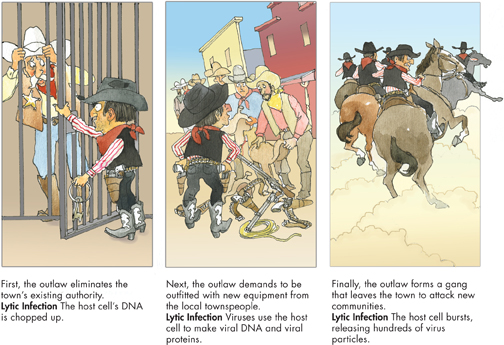Viral Infections
 What happens after a virus infects a cell?
What happens after a virus infects a cell?
After a virus has entered a host cell, what happens?  Inside living cells, viruses use their genetic information to make multiple copies of themselves. Some viruses replicate immediately, while others initially persist in an inactive state within the host. These two patterns of infection are called lytic infection and lysogenic infection.
Inside living cells, viruses use their genetic information to make multiple copies of themselves. Some viruses replicate immediately, while others initially persist in an inactive state within the host. These two patterns of infection are called lytic infection and lysogenic infection.
Lytic Infections In a lytic infection, a virus enters a bacterial cell, makes copies of itself, and causes the cell to burst, or lyse (LYS). Bacteriophage T4 is an example of a bacteriophage that causes such an infection. Bacteriophage T4 has a DNA core inside a protein capsid that binds to the surface of a host cell. The virus injects its DNA into the cell, and the cell then begins to make messenger RNA (mRNA) from the viral genes. The viral mRNA is translated into viral proteins that act like a molecular wrecking crew, chopping up the cell's DNA.
Under the control of viral genes, the host cell's metabolic system now makes thousands of copies of viral nucleic acid and capsid proteins. The viral DNA is assembled into new virus particles. Before long, the infected cell lyses, releasing hundreds of virus particles that may go on to infect other cells. In its own way, a lytic virus is similar to an outlaw in the Wild West of the American frontier, as illustrated in Figure 20–2.
VISUAL ANALOGY

FIGURE 20–2 How a Lytic Virus Is Like an Outlaw A lytic virus is similar to the Wild West of the American frontier in the demands the virus makes on its host. Use Analogies After you learn about lysogenic infections on the next page, modify this story to make it analogous to a lysogenic cycle.
d
Table of Contents
- Formulas and Equations
- Applying Formulas and Equations
- Mean, Median, and Mode
- Estimation
- Using Measurements in Calculations
- Effects of Measurement Errors
- Accuracy
- Precision
- Comparing Accuracy and Precision
- Significant Figures
- Calculating With Significant Figures
- Scientific Notation
- Calculating With Scientific Notation
- Dimensional Analysis
- Applying Dimensional Analysis




